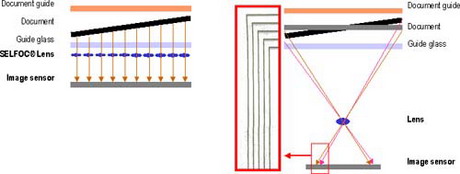Some of the world's greatest technology advancements have been the result of Canon Know How-exclusive innovations and proprietary technologies that empower consumers to do things faster and easier while maintaining the highest quality. Canon continues to uphold its world leadership in optical and imaging technology with numerous advancements in optical and imaging technology.
Some of the revolutionary new Canon technologies that take scanning to new heights are: CMOS (Contact Image Sensor Technology), AWF (Anti-Wrinkling Function Technology), RR (Roller Retard Technology), DFD (Double feed Detection Technology), Canofile Technology, CapturePerfect Technology and ISIS/TWAIN Technology.
The key to the DR scanners series compact size is its CMOS Contact Image Sensor.* This is a self-contained sensor unit with 3 major components: a row of sensor elements, thin optics, and a light source (LEDs). It is far smaller than conventional CCD-based sensor units, which use a bulky mirror-and-lens system known as "reduction optics." Reduction optics need a fair amount of space for their light path. For this reason, scanners with reduction optics are necessarily larger than the our DR scanners series.

A sensor unit with reduction optics has only one lens. So if a document is not completely flat on the guide glass, some points of the page will be farther from the lens than others. This will result in image distortion.
By contrast, in a lens array there are many small lenses, each of which is focused on one small area of the page. The sensor unit composes an image of the document by assembling the signals taken from each of these small areas.
When a document is not completely flat on the guide glass, this cannot be "seen" by any single lens.
Image distortion is minimized because a lens can hardly ever detect distortion in the one small part of the page it sees.
Sensor lighting has conventionally been applied only in the feed direction. This meant that creases or folds and wrinkles in the original tended to have an adverse effect on the corresponding parts of the scanning image. In contrast, the DR scanners uses lighting both from the font and rear and has a platen roller in close contact with the original to minimize the effect of wrinkles on the scanning image.
Canon's exclusive feeding mechanism eliminates "double feeds" (two or more pages being fed at the same time) to make sure that scans are completed as smoothly as possible.
There is a subtle difference in the way ultrasonic passes through one page from the way it passes through two pages.
The Ultrasonic Double Feed Detector detects this difference permits early double-feed detection and stops paper feed when a double-feed has been detected.
The immediate interruption of paper feed minimizes work time.
Split Image setting. When scanning a large document, such as a two-page spread on the flatbed, CapturePerfect can conveniently split the image down the middle and save the two images in separate files. Available file formats are TIFF, BMP, JPEG and PDF.
Scanning for PDG or email. With CapturePerfect, you can scan and save documents as searchable PDF files and prepare a batch of documents for immediate email delivery.
Display options. For quick and easy visual confirmation of document images, CapturePerfect can display thumbnail images as well as split-screen views.
Imprinter Feature. This allows for printing of text messages on the front of each scanned document.
Scanning batches into PDF files. With this, users can search for specific words and phrases later on, the copying of text data into other documents and small files through data compression.
Scan-to-Mail. For incredibly simple distribution of documents through email.
Prescan. So that users can adjust for brightness and/or contrast during scanning.
Advanced Text Enhancement. This significantly improves images scanned from documents written in light colours, on coloured backgrounds, in pencil or in thin writing.
Colour dropout function. Red, green or blue colour elements are removed or enhanced for sharper images.
Skip Blank Page function. This allows the scanning of one-sided and two-side documents in one batch by automatically discarding any blank pages.
Border Removal. The unattractive border around a document created when small documents or papers of non-standard sizes are scanned is replaced by white space.
Double Feed Detection. The ultrasonic double-feed detector senses the gap between two overlapping pages and stops the scanner when two or more pages are fed at the same time.
Skew Correction function. With this, pages that enter the scanner slightly skewed are automatically straightened.
Image Rotate Function. This allows the scanner to recognise the orientation of the characters and rotates the images to the right up-down orientation automatically.
Simple Staple Detection. This senses originals that are stapled together and stops paper feed immediately after detection.
Incorporated in most Canon scanners, the ISIS/TWAIN driver bestows an unparalleled bundle of mighty image processing functions on Canon scanners.
Advanced Text Enhancement. This function enhances the images from documents written in light colours, on coloured backgrounds, in pencil or in thin writing for greater legibility.
Color Dropout Function. Here, red, green or blue colour elements are removed or enhanced for sharper images.
Skip Blank Page Function. One-sided and two-sided documents can be scanned in the same batch as any blank pages are automatically discarded.
Skew Correction Function. Pages that enter the scanner slightly skewed are automatically corrected.
Image Rotate Function. This detects the direction of scanned image characters to display and save data in the correct direction.
MultiStream™ scanning. This technology enables users to produce two types of images with one scan, for example, a colour image for archiving and a black and white image for OCR.
Two options for duplex scanning. When scanning two-sided documents with ADF, users can select in advance the orientation of the back side of the document to obtain images with consistent orientation.
User Preferences. This allows 20 sets of setting preferences to be programmed, for users who frequently scan different types of documents.